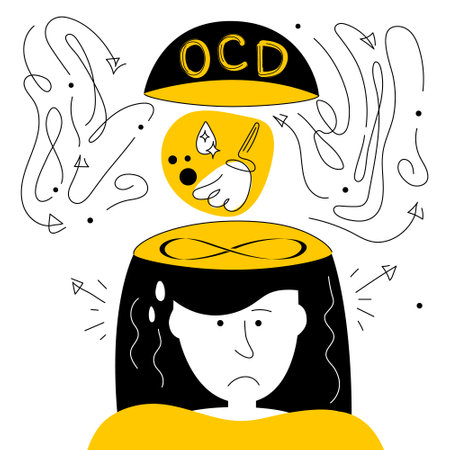
What is OCD?
“Every day feels like a battle I didn’t sign up for. It starts small, an unease I can’t quite shake. This morning, it’s the blanket on my bed. It doesn’t sit right. One corner droops lower than the other, and the sight of it makes my chest tighten. I tell myself it doesn’t matter, but the thought doesn’t let go. It’s not just in my head; it’s a physical discomfort, like an itch I can’t scratch.
I try to ignore it, but it’s impossible. The more I resist, the louder the thought gets. Fix it, or something will go wrong. I know that’s ridiculous, what could possibly happen because of a crooked blanket? But the feeling is so convincing, it overrides reason. So I smooth it out until it’s perfectly even, and for a brief moment, I feel relief. But it’s fleeting. There’s always something else.
Later, in the kitchen, I notice the chairs around the table aren’t aligned. My heart races. The thought returns, “Fix them”. I try to fight it, but it’s like holding my breath underwater, I can only last so long before the pressure becomes unbearable. Eventually, I give in. I straighten the chairs, stepping back to check and readjust over and over until they look right.
It’s exhausting. And the worst part? I know it’s irrational. I know the world won’t end if the chairs aren’t perfectly straight. But the doubt creeps in, What if you’re wrong? What if something bad happens because you didn’t fix it? I hate that these thoughts have this much power over me, but they do.
The compulsion brings relief, but it’s only temporary. The next intrusive thought is always around the corner. It’s like chasing a sense of “rightness” I can never reach. I feel ashamed for being controlled by something so irrational, but no amount of logic silences the storm in my head. People don’t see what’s really happening. To them, I’m just “detail-oriented” or “a neat freak.” They don’t see the constant battle to quiet a voice that never stops.
Sometimes, I try to resist. I force myself to sit with the discomfort, to prove to myself that nothing bad will happen. But it’s like standing on the edge of a cliff with the wind pushing me forward. Every second feels like I might lose control, and eventually, I give in just to make it stop.
It influences everything that I do. I have that same annoying thought, the same annoying fear on the way to my office, while I work, while I’m hanging out with my friends. It is something that I can’t escape from, something that I can’t control.
I hate this. I hate feeling trapped, knowing that I’m doing this to myself but still being unable to stop. It’s not about liking order; it’s about needing it, about surviving the endless noise in my mind. If I could walk away from it, I would in a heartbeat. But OCD doesn’t give me that choice. It’s always there, waiting for the next moment to take hold .”
Obsessive-Compulsive Disorder (OCD) is a mental health condition characterized by intrusive, unwanted thoughts (obsessions) or repetitive behaviors (compulsions ) or both performed to alleviate the distress caused by these thoughts. While everyone experiences occasional doubts or habits, OCD magnifies these experiences to an overwhelming degree, often interfering with daily life and functioning. At its core, OCD is not about quirks or preferences, it’s about an uncontrollable need to neutralize anxiety, even when the behaviors feel irrational.
Take, for instance, the story of someone living with Symmetry and Ordering OCD. For them, the day begins with a simple yet relentless discomfort: a crooked blanket that feels “wrong.” This unease isn’t just mental, it manifests physically, like an itch that demands attention. The intensity of the unease becomes too much and they feel compelled to fix it. The relief comes briefly but is fleeting. Soon, the same obsessive need reappears elsewhere, misaligned chairs, uneven objects, and the cycle begins again.
This story describes the core of OCD, the intrusive thought that something is wrong or out of place and the compulsion to fix it to stave off overwhelming anxiety. Yet, the relief provided by these actions is only temporary, and the thoughts return, louder and more demanding. The condition traps individuals in a loop of obsessions and compulsions, leaving them exhausted and frustrated.
People with OCD can be divided into three groups based on their level of insight: people with ‘good insight’, people with ‘poor insight’ and people with ‘absent insight’. People with good insight understand that their OCD beliefs are not true and are irrational. People with poor insight think that their OCD beliefs are probably true and people with absent insight are entirely convinced that their OCD beliefs are true.
The story presented above is an example of a person with OCD with good insight. For people with good insight, the hardest part of living with OCD is the awareness of its irrationality . The person knows the fears are exaggerated or baseless, but the compulsion to act feels overpowering. Logic alone can’t quiet the storm of anxiety and doubt and attempts to resist often amplify the distress. As the story shows, OCD isn’t about wanting things “perfect”; it’s about feeling controlled by a relentless need to alleviate unbearable tension.
For those with OCD, the struggle is deeply personal yet sometimes can be invisible to others . What may look like perfectionism or attention to detail is, in reality, a daily battle against unrelenting mental noise. While treatment through therapy and medication can help, living with OCD requires tremendous resilience and support.
Author: Karmendra Prakash Shrestha
